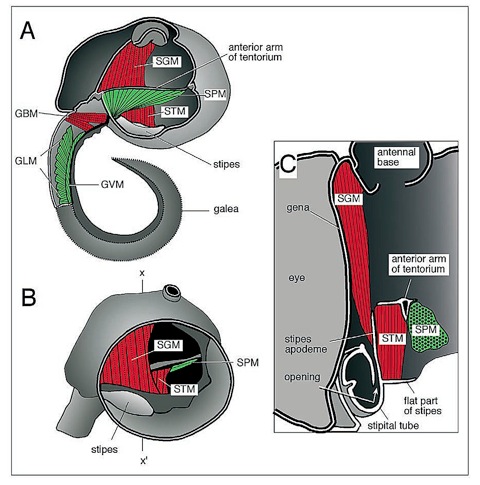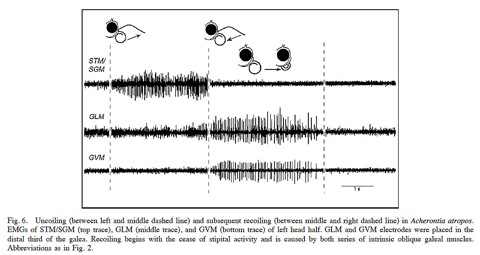Wannenmacher, G. and Wasserthal, L.T. (2003): Contribution of the maxillary muscles to proboscis movement in hawkmoths (Lepidoptera, Sphingidae) - an electrophysiological study. J. Insect Physiol. 49, 765-776.
The role of the maxillary muscles in the uncoiling and coiling movements of hawkmoths (Sphingidae) has been examined by electromyogram recordings, combined with video analysis. The maxillary muscles of adult Lepidoptera can be divided into two groups, galeal and stipital muscles. The galea contains two basal muscles (GBM) and two series of oblique longitudinal muscles (BLM, GVM), which run through the entire length of the galea. Three muscles insert on the stipes, taking their origin on the tentorium and on parts of the cranium and gena (STM, SPM, SGM), respectively. Proboscis extension is initiated by an elevation of the galea base caused by the basal galeal muscles (GBM). The actual uncoiling of the proboscis spiral is accompanied by rapid compressions of the stipites which are caused by two of the stipital muscles (red: STM, SGM). The study provides strong support for the hypothesis that uncoiling is brought about by an increase of hemolymph pressure by the stipites forcing hemolymph into the galeae. Recoiling is caused by the contraction of both sets of oblique longitudinal galeal muscles (green: GLM, GVM) supported by elasticity of the galea cuticle. Finally, the remaining stipital muscle (SPM) pulls down the galea base which brings the coiled proboscis back to its resting position where it is held in the U-shaped groove of the labium without further muscle activity.
Muscles for proboscis extension: GBM = basal galeal muscle, SGM = genal stipital muscle, STM = anterior tentorial stipital muscle,
Muscles for recoiling: GLM = longitudinal galeal muscle, GVM = ventral galeal muscle, SPM = posterior stipital muscle. 

